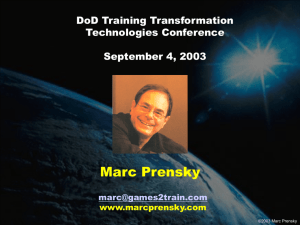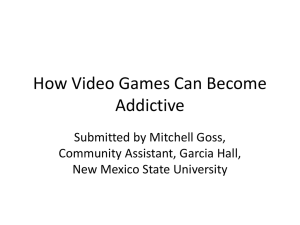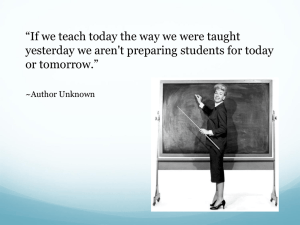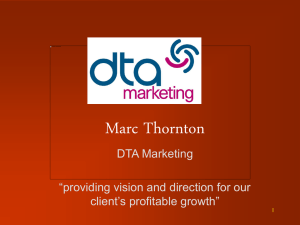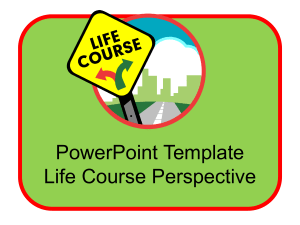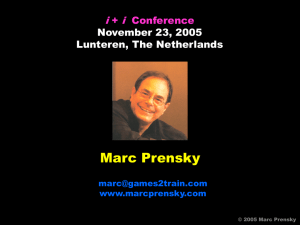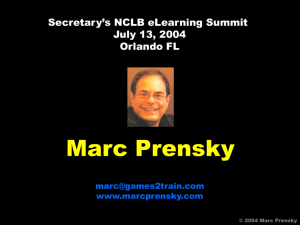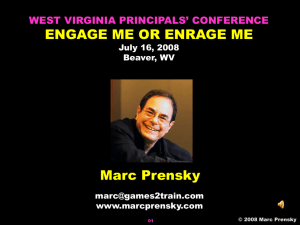(Prensky, 2001) Games are
advertisement
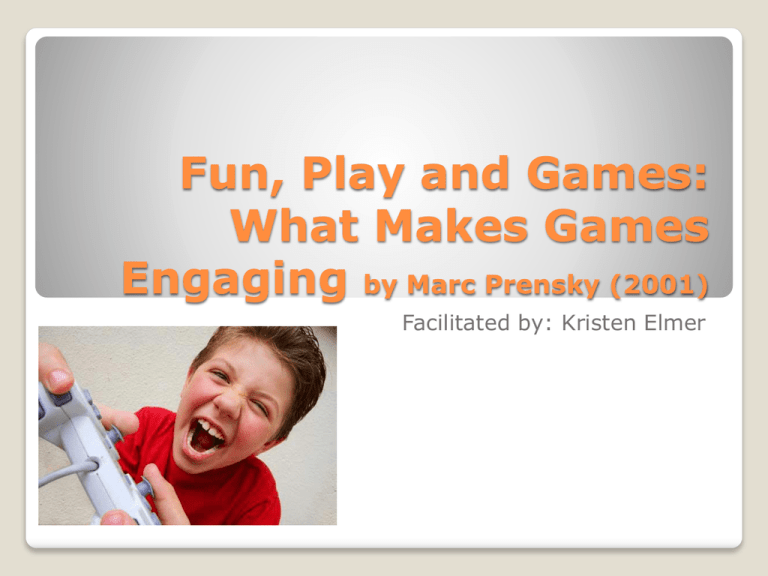
Fun, Play and Games: What Makes Games Engaging by Marc Prensky (2001) Facilitated by: Kristen Elmer Marc Prensky is an internationally acclaimed speaker, writer, consultant, and designer in the critical areas of education and learning. He is the author of Digital Game-Based Learning (McGraw-Hill, 2001),and Don't Bother Me Mom -- I'm Learning (Paragon House 2005), the founder and CEO of Games2train (whose clients include IBM, Nokia, Pfizer, the US Department of Defense and the LA and Florida Virtual Schools) and creator of the sites www.dodgamecommunity.com and www.socialimpactgames.com . Marc has created over 50 software games for learning, including the world's first fast-action videogame-based training tools and world-wide, multi-player, multi-team on-line competitions. He has also taught at all levels. Marc has been featured in articles in The New York Times and The Wall Street Journal, has appeared on CNN, MSNBC, PBS, and the BBC, and was named as one of training's top 10 "visionaries" by Training magazine. He holds graduate degrees from Yale (Teaching) and Harvard (MBA). (http://www.marcprensky.com/) WHO IS MARC PRENSKY? “Computer and videogames are potentially the most engaging pastime in the history of mankind” (Prensky, 2001) Games are: Fun, giving us enjoyment Play, giving us intense involvement Rules, giving us structure Goals, giving us motivation Interactive, giving us doing Adaptive, giving us flow Outcomes and Feedback, giving us learning Win States, giving us ego gratification Conflict/Competition/Challenge/Opposition, giving us adrenaline Problem-Solving, sparking creativity Interaction, giving us social groups Representation and Story, giving us emotion “People rarely succeed unless they have fun in what they are doing” –Dale Carnegie What is fun? Amusement, something amusing, mockery Make fun of somebody or something, poke fun at somebody or something A cheat or trick; a hoax, a practical joke To make fun of, or poke fun: to ridicule “On one hand fun is amusement, but on the other hand it is ridicule, or cheat or trick, or even sexual” (Prensky, 2001, p. 3). Fun: The Great Motivator “Fun in a positive sense is not passive, and can include a real exertion, as in sports or other competitions” “HARD FUN” The word fun cannot mean enjoyment, pleasure, amusement and ridicule. This is seen in the resistance by business people and educators to new learning approaches based on the connection to fun. Training and Learning can be related to the opposite of fun, pain. “No pain, no gain!” (Prensky, 2001, p. 4) Question to think about: How do you define fun? What do you associate with the word fun? How often is training/learning viewed as positive fun (enjoyment and pleasure) or negative fun (painful). Think about any of your current training or learning experiences. Fun Continued… “People with the notion that learning cannot and should not be fun are clearly in an archaic mode” – Mark Bieler What is the relationship between fun and learning? Fun helps to create relaxation and motivation in the learning process. Relaxation allows the learner to take things in more easily, and motivation allows them to put forth effort without resentment. Fun and Learning “Play is our brain’s favorite way of learning things” –Diane Ackerman What is PLAY? Play is something one chooses to do Play is intensely and utterly absorbing Play promotes the formation of social groupings (Prensky, 2001, p. 6) Play: The Universal Teacher “Play is the original way of learning things”- Danny Hillis How does play influence learning? “Play has a deep biological, evolutionary important, function, which has to do specifically with learning” (Prensky, 2001, p. 6). “Play is one of the cultural universals, something every single culture does” (Prensky, 2001, p. 6). Play and Learning “Great adults are driven to [play] too”-Danny Hillis People often separate their career or work from play. Scientists or artists consider their work to be so creative and fun that it can be seen as play. The best trainers and teachers try to make learning fun and playful. The Media Lab at MIT has a research division that investigates play and learning called the epistemology and learning group – the group focuses mostly on children’s learning, but many of their play oriented constructivist ideas are being extended to adults though computer games such as Roller Coaster Tycoon (Prensky, 2001, p.9). In an important paper “when play is productive” by Starbuck and Webster, play is defined as having 2 common elements. “Playful activities elicit involvement and give pleasure” (Prensky, 2001, p. 9). Question: Is it possible to “play” at work and still be productive? What limitations/barriers can cause people to feel like they can’t “play” at work? Play and Work “Epistemic games are computer games that can help players learn to think like engineers, urban planners, journalists, architects and other innovative professionals” http://www.youtube.com/w atch?v=hKyzsEytkQc “not just at set of technologies that were going to set out into the world, what we are designing is experienceslearning experiences for kids” Question: What do you think about this learning environment? Have you seen anything like this before? Epistemic Games Research Group “One of the most difficult tasks men can perform…is the invention of good games”-Carl Jung Game is a word of many meanings and implications Games are a subset of both play and fun. Games can be negatively defined as mocking or jesting, illegal and shady activity or positively defined as fun and games. Games involve rules, contest, rivalry and struggle. Games: Adding the Structure 6 Structural Factors in a Game: 1. 2. 3. 4. 5. 6. Rules Goals and Objectives Outcomes & Feedback Conflict/Competition/Challenge/Opposition Interaction Representation or Story What makes a Game a Game? Rules Rules differentiate games from other kinds of play Organized play (in other words, rule-based) Rules impose limits, forcing us to take a specific path to reach goals and ensure that all players take the same path Rules make things both fair and exciting Rules become more important as we get older In computer games, rules are built in the game “Metagaming” is a term that computer game designers use to describe not playing by the rules, but manipulating the rules and circumstances surrounding the game of your advantage. Magic, The Gathering card game was designed with the concept of metagaming. http://www.wizards.com/magic/TCG/newtomagic.aspx?x=mtg/tcg/newtoma gic/learntoplay Goals or Objectives “Goals differentiate games from other types of play, as well as from other non-goal-oriented games” (Prensky, 2001, p. 12). In a game, reaching your goals plays a big role in motivating you. The goals are often cited in the rules Outcomes and Feedback Refers to how you measure your progress against the goals. Feedback lets us know how we are doing in the game. Feedback can come in the form of a score or other ways. Through feedback we learn how the game works, how to succeed, how to get to the next level and win. Too much or too little feedback, can lead to the player becoming frustrated (Prensky, 2001, p. 13) Conflict/Competition/Challenge/ Opposition Refers to the problems in a game you are trying to solve. It is important to keep the level of challenge or opposition in tune with the players skill level, which is called balancing the game. Even cooperative games involve some kind of conflict or problem for the team to solve. (Prensky, 2001, p. 14) Interaction Refers to 2 aspects: 1. The Interaction of the Computer and the Player (Feedback) 2. The Inherently Social Aspect of Games Play promotes the formation of social groupings Computer games are actually bringing people into a closer social interaction, although its not face to face. (Prensky, 2001, p. 15) Representation Refers to the game being about something for example, chess is about conflict. Representation also includes the element of fantasy (Prensky, 2001, p. 15) What is “Flow”? Mental State of intense concentration Difficult tasks become easy Whatever you are doing becomes enormously pleasurable “In the flow state the challenges presented and your ability to solve them are almost perfectly matched, and you often accomplish things that you didn’t think you could, along with a great deal of pleasure” (Prensky, 2001) Question: Can you think of a time where you have experienced this state of flow? Have video games or computer games ever evoked this? Toys Interactions that have neither goals nor objectives Played with, explored Open-ended Stories or Narratives Another possible type of computer interaction Example is the ‘Living Books’ Series for Children Narratives are engaging because they stimulate our emotions Tools Interactive programs that are used to make other things (word processor or spreadsheet) Tools can be included in games either as an integral part of the game play or as supplements. Other types of Interactivity besides Games “Games and computers are one of the greatest marriages out there”Eric Goldberg Why do people prefer to play digital games? they take care of the boring stuff (rules, details) Typically faster and more responsive Funs things that digital games can do that other games cannot Capable of more, better and far more varied graphics Can be played with others and against the computer The whole world is available as potential players Can generate and allow huge numbers of options and scenarios Can deal with infinite amounts of content Can play at differing levels of challenge Can be updated instantly Can be customized to and by the desires of each player Can be modified and added to, making the player part of a creative team Question: Would you prefer a digital game over a traditional board game? Are there any advantages to playing non-computerized games? Digital Games Circa (2000) computer games fall into 8 genres: Action Games (Super Mario, Sonic, PacMan, Missle Command, Doom, Quake, Duke Nukem, Half-Life) Adventure Games (Zork, Myst, Riven, Zelda, the Ocarina of Time) Fighting Games (Mortal Kombat, Virtua Fighter) Puzzle Games (Tetris, Devil Dice) Role Playing Games (Ultima, EverQuest) Simulation Games (Sim City, The Sims) Sports Games Strategy Games (Civilization, Roller Coaster Tycoon) Which genre do you prefer? It can be Challenging to try a game you may not think your good at…you may surprise yourself! Game Taxonomy- Categories of Games “Game designers have a better take on the nature of learning than curriculum designers”- Seymour Papert Game Designers are: Not just nerds with ponytails and t-shirts They are the most talented and creative people of our generation! Are often unknowns Computer Game Design “Computer-based training designers could learn a lot from the people who build computer games”- Bob Filipczak 6 Elements found in every successful game throughout history: Balanced Creative Focused Character Tension Energy The Principles of a Good Game Design Processes used to create good games include: A Clear Overall Vision 2. A Constant Focus on the Player Experience 3. A Strong Structure 4. Highly adaptive 5. Easy to learn, hard to master 6. Stays within the “flow state” 7. Provides frequent rewards, not penalties 8. Includes Exploration and Discovery 9. Provides mutual assistance – thing helps solve another 10. Has an interface that is very useful 11. Includes the ability to save progress 1. Other Important Digital Game Design Elements The distinction between the way a game plays and how it looks Games gradually become more and more graphically detailed Some games don’t have complicated graphics, but they have a good rule structure (they are considered classic games, Tetris) Eye Candy vs. Game Play Some people are very specific in the types of games that they like, while others like more of a variety. Games are extremely age and culture specific. We often gravitate to the games we learned at an impressionable age. Knowing as much as possible about your intended audience is crucial to successful game design. (Prensky, 2001, p. 26). Digital Game Preferences: Culture and Individuals Adults and Games Adults sometimes shy away from learning new games Involves too much effort and practice Embarrassed to not be good at something Old hand-held games from the 70’s are being sold for $$$ (Frogger and Ms PacMan) http://www.freefrogger.org/welcome.html http://www.pacmangame.info/ms_pacman.html Age is no barrier to learning and playing computer games When one realizes what a particular game is about there is a big “aha” Question: What has been stopping you from trying a new game? Have you ever experienced a “aha” moment? What made you want to learn a new game or try something new on the computer? Digital Games and Age “There’s so much comedy on television. Does that cause comedy in the street?- Dick Cavett There are violent games, but games in of themselves are not violent The vast majority of digital games are not violent at all, including the best sellers (Sim City, The Sims, Roller Coaster Tycoon, Tetris, Myst and Riven) Action/fighting games are only one of the 8 genres of video and computer games Digital Games and Violence There has been a huge rise in the number of computer games designed for girls. There are more girls that are interested in computer games than there were in the 80s. There are lots of girls who like fighting and role playing adventure games. It is generally accepted that there is more women playing computer games, the dispute is how much are they playing and how fast. (Prensky, 2001, p. 29) Digital Games and Gender Every medium of communication has its own language There are sometimes shortcuts that we have to learn for a certain medium There is also a language or “rhetoric” of computer games Digital Game Players Know: You build things by clicking on an icon and dragging it to where you want it to go. You move people by selecting them and clicking them to where you want them to go. There are hidden combinations of keys that do interesting things. There are hidden surprises commonly known as “Easter Eggs” for you to find. There is almost always more then one way to do something. You may have to try something many times before it works. You can look up cheat codes on the internet. Games can always be saved and reloaded later. The “Language” of Digital Games “Barriers, Barriers, Barriers” What needs to be done? Moving the Curriculum into the 21st Century! http://www.youtube.com/watch?v=hmoVs4GYXUY Final Thoughts from Marc Prensky… References Prensky, M. (2001). Fun, Play and Games: What Makes Games Engaging. Digital Game-Based Learning. Retrieved May 4, 2009, from http://tinyurl.com/6l3amq

